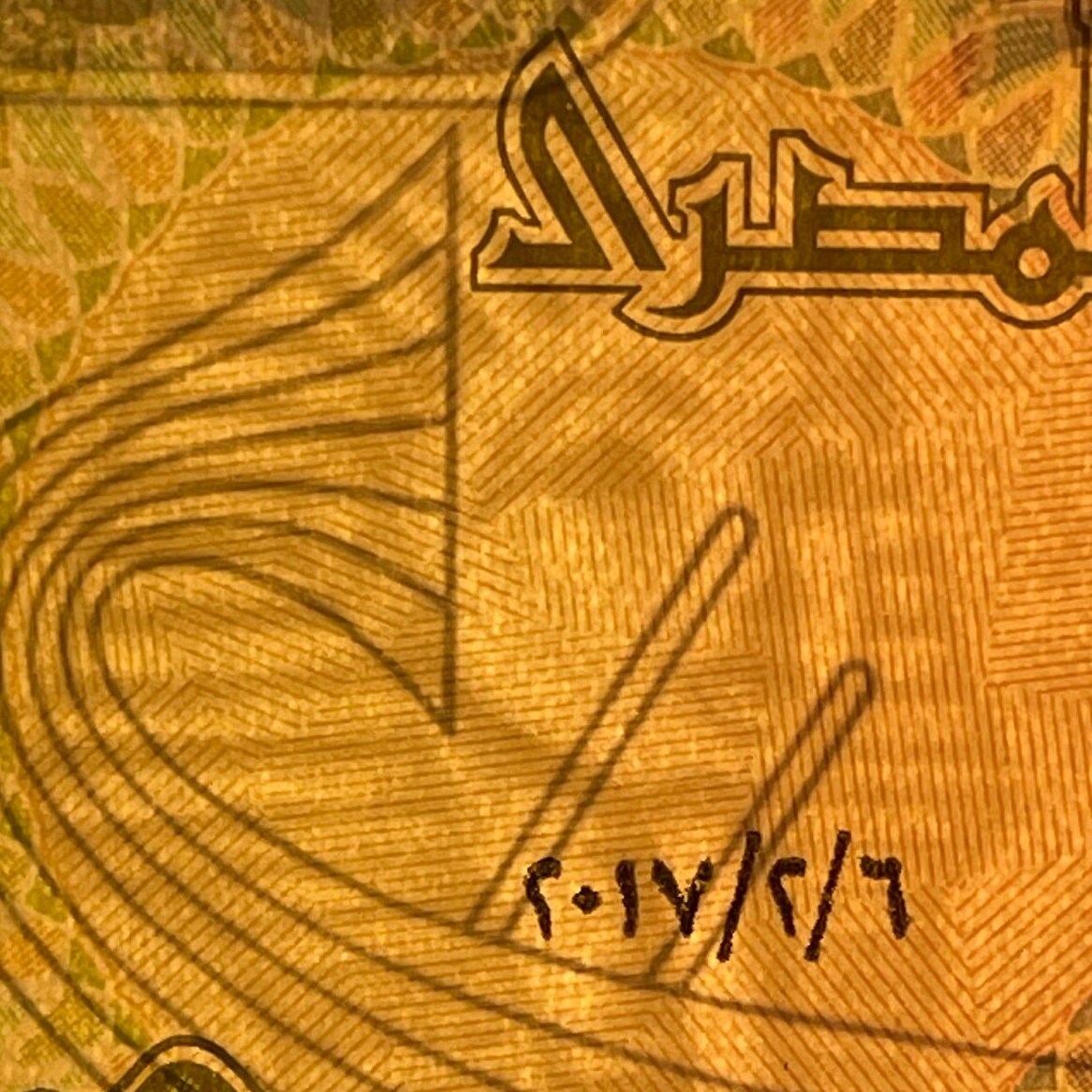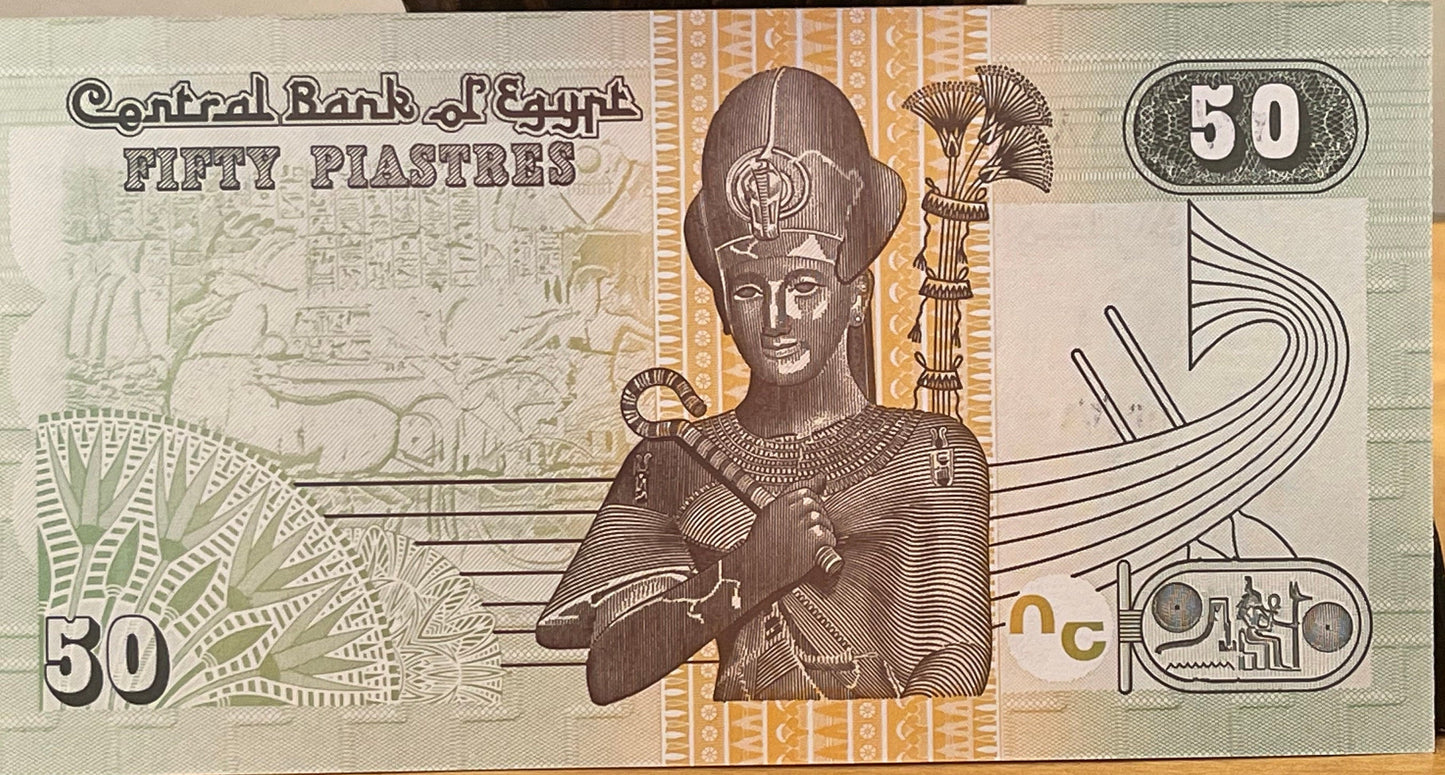elemintalshop
Pharaoh Ramesses the Great (Ozymandias) & Al Azhar Mosque 50 Piastres Egypt Authentic Banknote Money for Jewelry Collage Ramses II King Tut
Pharaoh Ramesses the Great (Ozymandias) & Al Azhar Mosque 50 Piastres Egypt Authentic Banknote Money for Jewelry Collage Ramses II King Tut
Couldn't load pickup availability
Pharaoh Ramesses the Great (Ozymandias) & Al Azhar Mosque 50 Piastres Egypt Authentic Banknote Money for Jewelry Crafts and Collage (Ramses II) (Watermark Statue of Tutankhamun) (Percy Shelley)
Reverse: The upper part of the statue of Pharaoh Ramesses II (Greek name: Ozymandias), backed by a vertical multi-colored ornamental band and a collection of lotus flowers and the sun boat. At the bottom right corner appears a Pharaonic cartouche. On the left side of the note is a drawing taken from the façade of a Pharaonic temple.
Lettering: Central Bank of Egypt
Fifty Piastres
Watermark: Statue of Tutankhamun -- AKA King Tut
Obverse: Al Azhar Mosque and its Minarets.
Al-Azhar Mosque (Al-Jāmiʿ al-ʾAzhar, lit. 'The Resplendent Congregational Mosque'), known simply in Egypt as al-Azhar. It is an Egyptian mosque in Islamic Cairo. Al-Mu'izz li-Din Allah of the Fatimid dynasty commissioned its construction for the newly established capital city in 970. Its name is usually thought to derive from az-Zahrāʾ (meaning "the shining one"), a title given to Fatimah. It was the first mosque established in Cairo, a city that has since gained the nickname "the City of a Thousand Minarets".
Features
Issuer Egypt
Issuing bank Central Bank of Egypt
Period Arab Republic of Egypt (1971-date)
Type Standard banknote
Year 2017
Value 50 Piastres
0.50 EGP = USD 0.032
Currency Pound (1916-date)
Composition Paper
Size 135 × 70 mm
Shape Rectangular
Number N# 203933
References P# 70
Wikipedia:
Ramesses II (c. 1303–1213 BC) was the third pharaoh of the Nineteenth Dynasty of Egypt. He is often regarded as the greatest, most celebrated, and most powerful pharaoh of the New Kingdom, itself the most powerful period of Ancient Egypt.
The name Ramesses is pronounced variously /ˈræməsiːz, ˈræmsiːz, ˈræmziːz/. Other spellings include Rameses and Ramses; in Koinē Greek: Ῥαμέσσης, romanized: Rhaméssēs. The name means "Ra is the one who bore him" or "born of Ra". He is known as Ozymandias in Greek sources (Koinē Greek: Οσυμανδύας, romanized: Osymandýas), from the first part of Ramesses's regnal name, Usermaatre Setepenre, "The Maat of Ra is powerful, Chosen of Ra". He is also called Ramesses the Great. His successors and later Egyptians called him the "Great Ancestor".
At age fourteen, he was appointed prince regent by his father, Seti I. Most Egyptologists today believe he assumed the throne on 31 May 1279 BC, based on his known accession date of III Season of the Harvest, day 27.
The early part of his reign was focused on building cities, temples, and monuments. He established the city of Pi-Ramesses in the Nile Delta as his new capital and used it as the main base for his campaigns in Syria. He led several military expeditions into the Levant, reasserting Egyptian control over Canaan. He also led expeditions to the south, into Nubia, commemorated in inscriptions at Beit el-Wali and Gerf Hussein. He celebrated an unprecedented thirteen or fourteen Sed festivals during his reign—more than any other pharaoh.
Estimates of his age at death vary; 90 or 91 is considered most likely. On his death, he was buried in a tomb in the Valley of the Kings; his body was later moved to a royal cache where it was discovered in 1881, and is now on display in the Egyptian Museum.
Death and legacy
The Egyptian scholar Manetho (third century BC) attributed Ramesses a reign of 66 years and 2 months.
By the time of his death, aged about 90 years, Ramesses was suffering from severe dental problems and was plagued by arthritis and hardening of the arteries. He had made Egypt rich from all the supplies and bounty he had collected from other empires. He had outlived many of his wives and children and left great memorials all over Egypt. Nine more pharaohs took the name Ramesses in his honour.
In popular culture
Ramesses is the basis for Percy Bysshe Shelley's poem "Ozymandias". Diodorus Siculus gives an inscription on the base of one of his sculptures as: "King of Kings am I, Osymandias. If anyone would know how great I am and where I lie, let him surpass one of my works." This is paraphrased in Shelley's poem.
The life of Ramesses II has inspired many fictional representations, including the historical novels of the French writer Christian Jacq, the Ramsès series; the graphic novel Watchmen, in which the character of Adrian Veidt uses Ramesses II to form part of the inspiration for his alter-ego, Ozymandias; Norman Mailer's novel Ancient Evenings, which is largely concerned with the life of Ramesses II, though from the perspective of Egyptians living during the reign of Ramesses IX; and the Anne Rice book The Mummy, or Ramses the Damned (1989), in which Ramesses was the main character. In The Kane Chronicles Ramesses is an ancestor of the main characters Sadie and Carter Kane.
The East Village underground rock band The Fugs released their song "Ramses II Is Dead, My Love" on their 1968 album It Crawled into My Hand, Honest.
As the pharaoh of the Exodus
In entertainment and media, Ramesses II is one of the more popular candidates for the Pharaoh of the Exodus. He is cast in this role in the 1944 novella The Tables of the Law by Thomas Mann. Although not a major character, Ramesses appears in Joan Grant's So Moses Was Born, a first-person account from Nebunefer, the brother of Ramose, which paints a picture of the life of Ramose from the death of Seti, replete with the power play, intrigue, and assassination plots of the historical record, and depicting the relationships with Bintanath, Tuya, Nefertari, and Moses.
In film, Ramesses is played by Yul Brynner in Cecil B. DeMille's classic The Ten Commandments (1956). Here Ramesses is portrayed as a vengeful tyrant as well as the main antagonist of the film, ever scornful of his father's preference for Moses over "the son of [his] body". The animated film The Prince of Egypt (1998) also features a depiction of Ramesses (voiced by Ralph Fiennes), portrayed as Moses' adoptive brother, and ultimately as the film's villain with essentially the same motivations as in the earlier 1956 film. Joel Edgerton played Ramesses in the 2014 film Exodus: Gods and Kings. Sérgio Marone plays Ramesses in the 2015 Brazilian series Os Dez Mandamentos (English: 'Moses and the Ten Commandments').
In video games, Ramesses II is one of the characters of the Video Game Civilization 5
******
"Ozymandias" (/ˌɒziˈmændiəs/) is a sonnet written by the English Romantic poet Percy Bysshe Shelley (1792–1822). It was first published in the 11 January 1818 issue of The Examiner of London. The poem was included the following year in Shelley's collection Rosalind and Helen, A Modern Eclogue; with Other Poems, and in a posthumous compilation of his poems published in 1826.
Shelley wrote the poem in friendly competition with his friend and fellow poet Horace Smith (1779–1849), who also wrote a sonnet on the same topic with the same title. The poem explores the fate of history and the ravages of time: even the greatest men and the empires they forge are impermanent, their legacies fated to decay into oblivion.
Publication history
The banker and political writer Horace Smith spent the Christmas season of 1817–1818 with Percy Bysshe Shelley and Mary Shelley. At this time, members of the Shelleys' literary circle would sometimes challenge each other to write competing sonnets on a common subject: Shelley, John Keats and Leigh Hunt wrote competing sonnets about the Nile around the same time. Shelley and Smith both chose a passage from the writings of the Greek historian Diodorus Siculus in Bibliotheca historica, which described a massive Egyptian statue and quoted its inscription: "King of Kings Ozymandias am I. If any want to know how great I am and where I lie, let him outdo me in my work." In Shelley's poem, Diodorus becomes "a traveller from an antique land."
The poem was printed in The Examiner, a weekly paper published by Leigh's brother John Hunt in London. Hunt admired Shelley's poetry and many of his other works, such as The Revolt of Islam, were published in The Examiner.
Shelley's poem was published on 11 January 1818 under the pen name "Glirastes". It appeared on page 24 in the yearly collection, under Original Poetry. Shelley's poem was later republished under the title "Sonnet. Ozymandias" in his 1819 collection Rosalind and Helen, A Modern Eclogue; with Other Poems by Charles and James Ollier and in the 1826 Miscellaneous and Posthumous Poems of Percy Bysshe Shelley by William Benbow, both in London.
I met a traveller from an antique land
Who said: "Two vast and trunkless legs of stone
Stand in the desert. Near them, on the sand,
Half sunk, a shattered visage lies, whose frown,
And wrinkled lip, and sneer of cold command,
Tell that its sculptor well those passions read
Which yet survive, stamped on these lifeless things,
The hand that mocked them and the heart that fed:
And on the pedestal these words appear:
My name is Ozymandias, king of kings;
Look on my works, ye Mighty, and despair!
Nothing beside remains. Round the decay
Of that colossal wreck, boundless and bare
The lone and level sands stretch far away."
— Percy Shelley's "Ozymandias"
*******
Wikipedia:
Al-Azhar Mosque (Arabic: الجامع الأزهر, romanized: al-Jāmiʿ al-ʾAzhar, lit. 'The Resplendent Congregational Mosque'), known simply in Egypt as al-Azhar, is an Egyptian mosque in Islamic Cairo. Jawhar al-Siqilli commissioned its construction for the newly established capital city in 970. Its name is usually thought to derive from az-Zahrāʾ (meaning "the shining one"), a title given to Fatimah bent Muhammad, the Prophet of Islam. It was the first mosque established in Cairo, a city that has since gained the nickname "the City of a Thousand Minarets".
After its dedication in 972, and with the hiring by mosque authorities of 35 scholars in 989, the mosque slowly developed into what is today the second oldest continuously run university in the world after Al Karaouine in Idrisid Fes. Al-Azhar University has long been regarded as the foremost institution in the Islamic world for the study of Sunni theology and sharia, or Islamic law. The university, integrated within the mosque as part of a mosque school since its inception, was nationalized and officially designated an independent university in 1961, following the Egyptian Revolution of 1952.
Over the course of its over a millennium-long history, the mosque has been alternately neglected and highly regarded. Because it was founded as a Shiite Ismaili institution, Saladin and the Sunni Ayyubid dynasty that he founded shunned al-Azhar, removing its status as a congregational mosque and denying stipends to students and teachers at its school. These moves were reversed under the Mamluk Sultanate, under whose rule numerous expansions and renovations took place. Later rulers of Egypt showed differing degrees of deference to the mosque and provided widely varying levels of financial assistance, both to the school and to the upkeep of the mosque. Today, al-Azhar remains a deeply influential institution in Egyptian society that is highly revered in the Sunni Muslim world and a symbol of Islamic Egypt.
Share










5 stars review from Vanessa
Secure packaging and quick shipping! I was a little worried about ordering a bank note instead of a coin, but it was for no reason. The condition is perfect.
5 stars review from Kate
I bought this for my ancient Egypt-obsessed 11-year-old as a stocking-stuffer. She has also been fascinated by old pennies and foreign currency, so she really enjoyed receiving this gift. It arrived quite promptly in time for the holidays.









